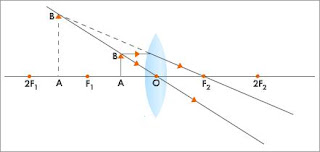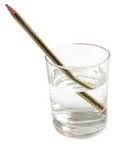We ♥ Physic
Sunday, 2 October 2011
Friday, 16 September 2011
5.4 Understanding Lenses
There are 2 types of lenses
(1) Convex lenses
(2) Concave lenses
~Convex lenses are thicker in the centre than at the edge.
~Cross-sectional views of common types of convex lenses:
Images formed by Concave Lenses
(1) Convex lenses
(2) Concave lenses
Differences between convex and concave lenses
(a)convex lenses
~Convex lenses are also known as converging lenses or positive lenses.~Convex lenses are thicker in the centre than at the edge.
~Cross-sectional views of common types of convex lenses:
~Convex lenses refract incident rays of light,which are parallel to the principal axis,so that they converge to a point on the principal axis.This point is called the real principal focus.
(b)concave lenses
~Concave lenses are also known as diverging lenses or negative lenses.
~Concave lenses are thinner in the centre than at the edge.
~Cross-sectional views of common types of concave lenses:
~Concave lenses refract incident rays of light , which are parallel to the principle axis ,so that they appear
to diverge from a point located on the incident side of the principal axis. This point is called the virtual
principal focus.
Common terminology
(a) convex lens
(b) concave lens
Power of a lens
*The power of a lens is a measure of the ability of the lens to converge or diverge rays of light.
*The formula for the power of a lens is:
Power(D)=1/Focal length(m)
=1/f
*unit of the power of lens is dioptres or D.
*A convex lenses has a positive focal length and power.
*A concave lenses has a negative focal length and power.
Ray Diagrams
*to determine the position and characteristics of images formed by lenses for any position of the object.
*can be completed using any two out of the three rays of light.
Images Formed by Convex Lenses
(a) Distant object , u = infinity
Image distance: v = f
*Real
*Inverted
*Diminished
*On the opposite side of the object
(b)Object distance is more than 2f, u>2f
Image distance: f<v<2f
*Real
*Inverted
*Diminished
*On the opposite side of the object
(c)Object distance is equal to 2f ,u=2f
Image distance : v = 2f
*Real
*Inverted
*Same size as object
*On the opposite side of the object
(d)Object distance is between f and 2f , ,f<u<2f
Image distance:v>2f
*Real
*Inverted
*Magnified
*On the opposite side of the object
(e)Object distance is equal to f, u=f
Image is at infinity
*virtual
*Upright
*Magnified
*On the same side as the object
(f)Object distance is less than f ,u<f
Object distance:v>u
*virtual
*upright
*magnified
*On the same side as the object
Images formed by Concave Lenses
*do not depend on the position of the object with respect to the lens
*an image formed by a concave lens is a always
(a)virtual
(b)upright
(c)smaller than the object
(d)located between the lens and the object
(e)the image distance is less than the focal length
Linear Magnification
*the ratio of the size of the image to the size of the object.
Linear magnification, m=size of image/size of object
The Use of Lenses in Optical Devices
Differences between microscope and telescope
(a) Microscope
*A compound microscope is an optical instrument used to view very small or fine objects.
*A compound microscope consists of two convex lenses of high power.
(a) The lens nearer the object is called the objective lens , with focal length,f。
(b) The lens nearer the eye is called the eyepiece , with focal length,fe'
*The objective les has a higher power as it has a shorter focal length compared to the eyepiece.
(b)Astronomical Telescope
*an astronomical telescope is an optical instrument that is used to view object at a great distance , such as
planet and stars.
*an astronomical telescope consists of two convex lenses. The objective lens whose power is low has along focal length,fo.The eyepiece whose power is high has a short focal length fe.
*the distance between the objective lens and the eyepiece is (fo+fe).
Thursday, 15 September 2011
5.3 Understanding total internal reflection of light
~Total internal reflection is the total reflection of a beam of light at the boundary of two mediums,when the angle of incidence in the optically denser medium exceeds a specific critical angle.
~The Critical angle is the angle of incidence in the optically denser medium for which the angle of refraction,
r = 90degree
~conditions required for the occurrence of total internal reflection :
(a) light ray must travel from an optically denser medium to a less dense medium.
(b) angle of incidence must be greater than the critical angle,that is ,i >c
Relationship between Critical Angle,c and Refraction Index,n
~The refractive index of glass,
n=sin i(in air)/sin r(in glass)
=sin 90 degree/sin c
=1/sin c
Effect of a prism on light rays
~The rays of light are deflected by 90 degree.
~The Critical angle is the angle of incidence in the optically denser medium for which the angle of refraction,
r = 90degree
~conditions required for the occurrence of total internal reflection :
(a) light ray must travel from an optically denser medium to a less dense medium.
(b) angle of incidence must be greater than the critical angle,that is ,i >c
Relationship between Critical Angle,c and Refraction Index,n
~The refractive index of glass,
n=sin i(in air)/sin r(in glass)
=sin 90 degree/sin c
=1/sin c
Effect of a prism on light rays
~The rays of light are deflected by 90 degree.
~The two rays of light are inverted.
~The two rays of light are deflected bu 180 degree.
Natural Phenomena and the Uses of Total Internal Reflection
(a)A rainbow formed because of refraction,dispersion and total internal refraction of light which passes though water droplets in the air,
(b)Light is refracted and dispersed into its various colour components when it enters the raindrops.
(c)It then undergoes total internal reflection at the back of the raindrops and then refracted again as it leaves.
(a)A fish or a diver is able to see an object above the water surface because the rays of light from the object are refracted to the eyes of the fish or diver.
(b)Due to total internal reflection,part of the water surface acts as a perfect mirror,which allow the fish and diver to see objects in the water and the objects around obstacles.
Applications of Total Internal Reflection
1.The critical angle of glass is around 42 degree.
2.A prism is made of a high-density optical medium such as glass.
3.When light from the air strikes a prism at right angle,no refraction occurs.If after through the prism,it hits the opposite surface,internal total reflection occurs.Because the angle of incidence which is 45 degree is greater than the critical angle of glass which is only 42 degree.
~A prism is a better reflector compared to a mirror because of the following reasons.
(a)Ordinary mirrors give multiple images due to multiple reflections in the glass at the front of the mirror.
(b)The silvering on the mirror is easily damaged.
(c)A mirror reflects less light than a totally-reflection prism.
Tuesday, 13 September 2011
5.2 Understanding refraction of light
~Refraction of light is a phenomenon where the direction of light is changed when it crosses the boundary between two materials of different optical densities.
~Refraction of light occurs as a result of a change in the velocity of light as it passes from one medium into another medium.

*Angle of incidence,i is the angle between the incident ray and the normal.
*Angle of refraction,r is the angle between the refracted ray and the normal.
Laws of Refraction
~the incident ray,the refracted ray and the normal to the interface are all lie in the same plane.
~the value of sin i /sin r is constant.
~is known as snell' law.
Refraction index and the Speed of Light
~amount of bending depends on the ratio of speed of light in a vacuum to the speed of light in the medium.
~this ratio is called the refractive index of the medium.
n = speed of light in vacuum /speed of light in the medium
= c / v
Substance Refractive index
Air 1.00
Vacuum 1.00
Water 1.33
Ice 1.31
Glass 1.50
Perspex 1.49
Diamond 2.40
Apparent Depth and Actual Depth
(a) Apparent Depth ,d
The distance of the image from the surface of the water
(b) Actual Depth
The distance of the object from the surface of the water
Refractive index,n = Real depth,D / Apparent depth,d
~Refraction of light occurs as a result of a change in the velocity of light as it passes from one medium into another medium.

*Angle of incidence,i is the angle between the incident ray and the normal.
*Angle of refraction,r is the angle between the refracted ray and the normal.
Laws of Refraction
~the incident ray,the refracted ray and the normal to the interface are all lie in the same plane.
~the value of sin i /sin r is constant.
~is known as snell' law.
Refraction index and the Speed of Light
~amount of bending depends on the ratio of speed of light in a vacuum to the speed of light in the medium.
~this ratio is called the refractive index of the medium.
n = speed of light in vacuum /speed of light in the medium
= c / v
Substance Refractive index
Air 1.00
Vacuum 1.00
Water 1.33
Ice 1.31
Glass 1.50
Perspex 1.49
Diamond 2.40
Apparent Depth and Actual Depth
(a) Apparent Depth ,d
The distance of the image from the surface of the water
(b) Actual Depth
The distance of the object from the surface of the water
Refractive index,n = Real depth,D / Apparent depth,d
(a) a man standing in a boat and observes an object in the sea.
(b) ray of light from the object travel from water to air.
(c)water is denser than water.
(d) rays of light refract away from the normal as they leave the water .
(e) the rays of light enter the eyes of the observer.
(f) the observer see a virtual image above the object.
(g) so the object appears to be nearer the surface of the water.
(a) water is denser than air.
(b) when the light rays emerge from the surface of the water,they are refracted away from the normal.
(c) the emergent light rays appear to originate from the position of the virtual image.
(d) the light rays from all the points along the length of the pen immersed in the water are similarly refracted.
(e) the submerged portion of the pen appears to the above of object.
(f) so giving the impression that the pen is bent.
Saturday, 10 September 2011
3.Telescope
~use for to look at object which are far away.
~concave mirror is placed at the bottom of the telescope to collect light.
~the object produces parallel rays when they reach the mirror.
~concave mirror concentrates the light at the principle focus of the mirror
~use for to look at object which are far away.
~concave mirror is placed at the bottom of the telescope to collect light.
~the object produces parallel rays when they reach the mirror.
~concave mirror concentrates the light at the principle focus of the mirror
2. Kaleidoscope
~two plane mirror inclined at any angle produce multiple reflections
~more than 1 image will be formed in both mirror
~multiple reflections in plane mirror are at 60 to each other
~plane mirror strips of equal length and width are fixed tightly against each other inside a card board tube
~two plane mirror inclined at any angle produce multiple reflections
~more than 1 image will be formed in both mirror
~multiple reflections in plane mirror are at 60 to each other
~plane mirror strips of equal length and width are fixed tightly against each other inside a card board tube
Subscribe to:
Comments (Atom)
























